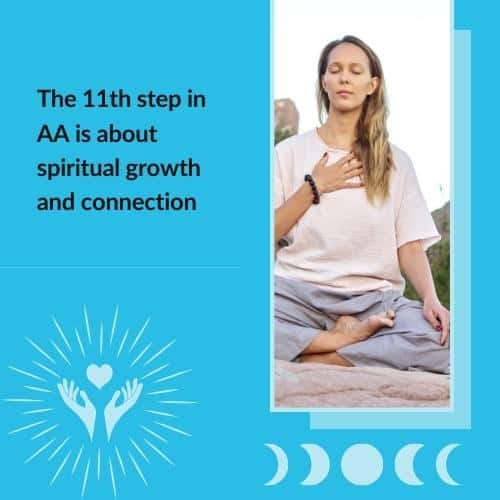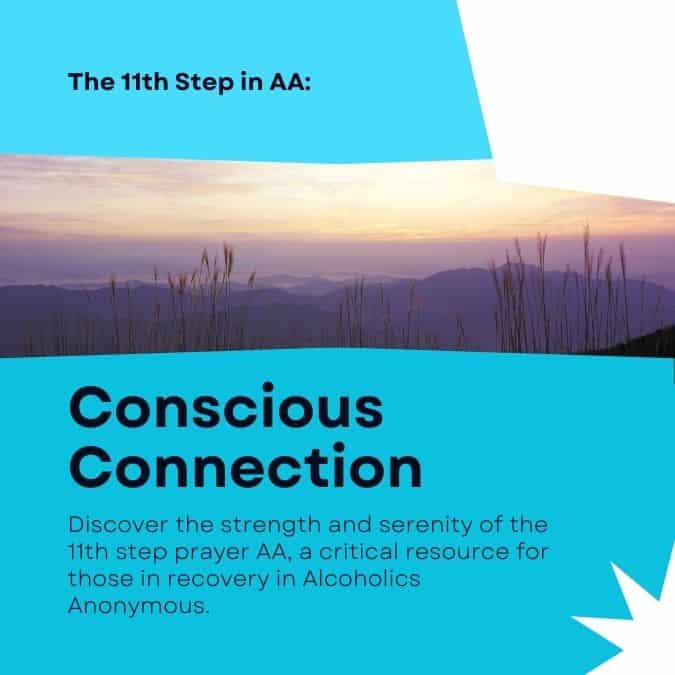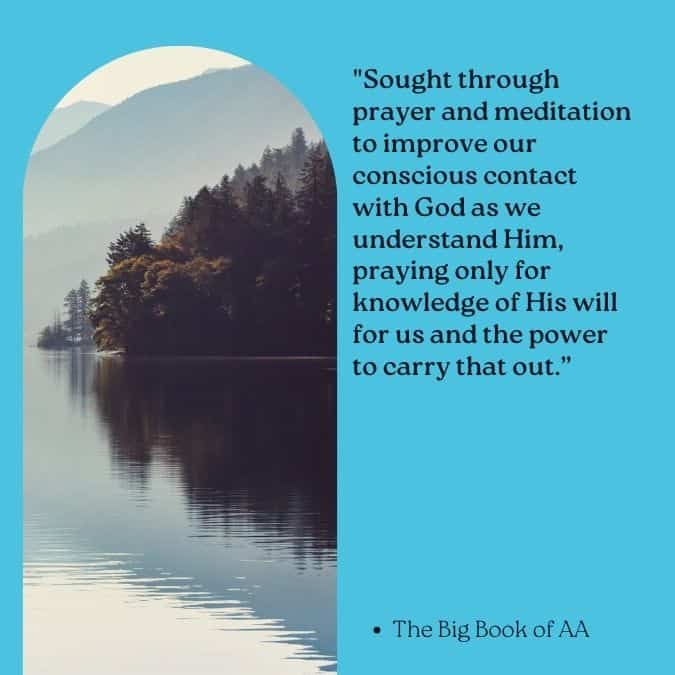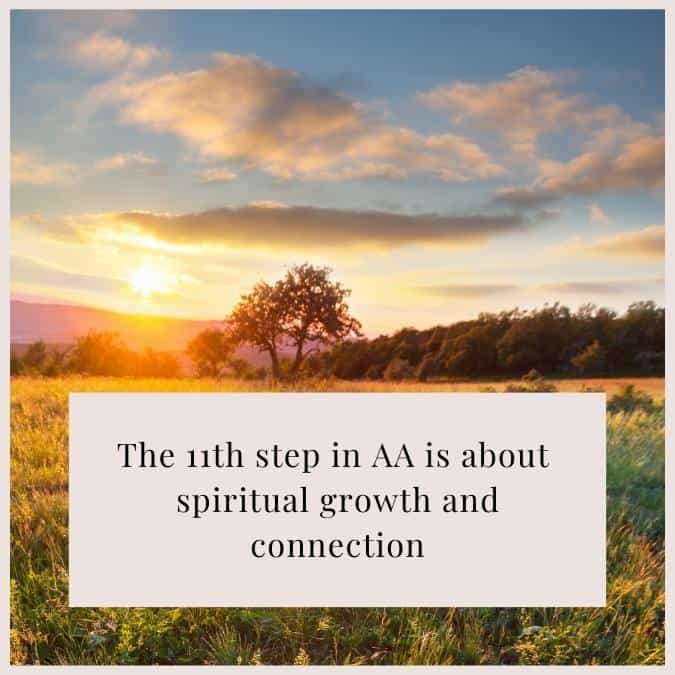
The journey to sobriety is a deeply personal one, often marked by moments of introspection, challenges, and profound growth. The 11th step of Alcoholics Anonymous stands out as a pivotal point, emphasizing the significance of prayer and meditation in fostering a conscious connection with a higher power. The 11th step prayer in AA can be transformative, especially for those new to the AA program.
- Understanding Step 11 in AA: Delving into the essence of the 11th step and its significance in the AA journey.
- The Essence of Step 11 Prayers: Exploring the various prayers associated with this step and their intended purpose.
- Diverse Approaches to Step 11: Emphasizing the flexibility of this step and the various ways it can be practiced.
- Daily Practice: To Do or Not to Do?: Discussing the frequency of practicing Step 11 and the importance of personalizing one’s approach.
Understanding The 11th step prayer in AA
In the realm of Alcoholics Anonymous, Step 11 serves as a cornerstone, emphasizing the importance of spiritual growth and connection. As articulated in the Big Book of Alcoholics Anonymous, this step encourages individuals to “Sought through prayer and meditation to improve our conscious contact with God as we understand Him, praying only for knowledge of His will for us and the power to carry that out.” That’s kind of a mouthful, but we will break it down together here. Remeber, this step is not about rigid rituals but rather about fostering a genuine connection with one’s higher power.
Quick Breakdown of the previous AA quote:
 – Use prayer and meditation as tools.
– Use prayer and meditation as tools.
– Try to build a better connection with God (or however you personally see or understand a higher power).
– When praying, ask to understand what God wants for us.
– Also, ask for the strength and ability to do what God wishes for us.
From my years of experience working with individuals on their recovery journey, I’ve witnessed the transformative power of this step. One of my clients once shared how the 11th step became his anchor, helping him navigate the tumultuous waters of early sobriety. By seeking a deeper understanding of this step, you’re not only strengthening your spiritual foundation but also equipping yourself with tools to face life’s challenges head-on.
For a comprehensive overview of the AA program, the AA preamble serves as an excellent starting point.
The 11th step prayer AA: Four Main Prayer Topics
a. Morning Prayer
Starting the day with a clear intention can set a positive tone. The morning prayer, “God, direct my thinking, especially that it be divorced from self-pity, dishonest, or self-seeking motives,” serves this purpose. It’s a call for clarity, guidance, and selflessness as one navigates the day’s challenges.
b. Decisive Prayer
Life often presents us with crossroads, moments of indecision where we seek guidance. The prayer, “God, give me inspiration, an intuitive thought or decision,” becomes a beacon during such times, helping individuals align with their higher power’s will.
c. Mid-Morning Reflection
As the day progresses, taking a moment for reflection can realign one’s focus. The prayer, “God, show me all throughout my day what my next step is to be. Give me whatever I need to take care of any problems. I ask especially for freedom from self-will,” serves this purpose, ensuring one remains on their spiritual path.
d. Surrendering Prayer
In moments of struggle or despair, the simple yet profound phrase, “Thy will be done,” becomes a mantra of surrender and trust in the divine plan.
For those keen on understanding the broader framework of AA, the AA 10th step offers valuable insights.
Related Article: 12 Steps of AA
Diverse Approaches to Step 11
 While the 11th step prayers are invaluable tools in the AA journey, Step 11 is about more than just reciting words. It’s about actively seeking and nurturing a conscious connection with a higher power, personalized to one’s understanding and beliefs.
While the 11th step prayers are invaluable tools in the AA journey, Step 11 is about more than just reciting words. It’s about actively seeking and nurturing a conscious connection with a higher power, personalized to one’s understanding and beliefs.
a. Exploring Different Paths
Step 11 encourages individuals to find what resonates most with their higher power. This might mean exploring various avenues for spiritual connection, tailored to their unique beliefs and experiences.
b. Nature’s Sanctuary
For many, nature serves as a conduit for spiritual connection. Whether it’s a serene walk in the woods, a challenging mountain hike, or simply basking in the beauty of a sunset, nature offers countless opportunities to connect with one’s higher power. I recall a patient who found solace in the Wasatch Mountains, much like the serene surroundings of our Addiction Recovery Center.
c. Acts of Service
Acts of service, whether volunteering or supporting loved ones, can be a profound way to practice Step 11. By embodying the principles of a higher power through kindness and compassion, one deepens their spiritual connection.
d. Group Meetings
Attending AA meetings is another way to foster a connection with a higher power. Sharing experiences, seeking guidance, and offering support within the AA community can be a powerful manifestation of Step 11. For those new to AA, understanding common AA slogans can be a helpful introduction.
Daily Practice: The 11th step prayer in AA
The frequency of practicing Step 11 is deeply personal. While some find solace in daily rituals, others might resonate with a more flexible approach.
a. Daily Practice
Incorporating morning and evening prayers or meditation can provide structure and consistency. However, it’s essential to ensure these practices stem from a genuine desire for connection rather than mere routine.
b. Alternatives to Daily Practice
For those who find daily rituals overwhelming, there are numerous other ways to practice Step 11. This might mean attending AA meetings, setting aside specific days for reflection, or simply being mindful of one’s actions and intentions throughout the day.
For a deeper dive into daily practices and the principles of AA, the concept of ODAAT (One Day At A Time) offers valuable insights.
VI. Conclusion
 Step 11 in AA is more than just a step; it’s a journey towards spiritual growth and a conscious connection with a higher power. While the 11th step prayers offer valuable guidance, the essence of this step goes beyond mere words. It’s about embracing flexibility, seeking diverse paths of connection, and continuously striving for a life guided by divine will.
Step 11 in AA is more than just a step; it’s a journey towards spiritual growth and a conscious connection with a higher power. While the 11th step prayers offer valuable guidance, the essence of this step goes beyond mere words. It’s about embracing flexibility, seeking diverse paths of connection, and continuously striving for a life guided by divine will.
In my years of working with individuals on their path to recovery, I’ve witnessed the transformative power of Step 11. It’s not just about reciting prayers but about living them, embodying their essence in daily life. Whether through structured prayers, moments of reflection in nature, acts of service, or the supportive community of AA, Step 11 offers myriad ways to strengthen one’s spiritual foundation.
For individuals contemplating the AA journey, understanding Step 11 can be a beacon of hope and guidance. It’s a reminder that recovery is not just about abstaining from alcohol but about building a life filled with purpose, connection, and spiritual growth.
As you embark on or continue your journey towards sobriety, remember that you’re not alone. Resources like the AA promises and the supportive community at our Addiction Recovery Center in the serene foothills of the Wasatch Mountains are here to guide and support you every step of the way.
Embrace the journey, trust the process, and always remember that with faith, determination, and the right support, a life of sobriety and spiritual fulfillment is within reach.
For a deeper understanding of AA’s principles and promises, consider exploring the AA promises, the meaningful AA slogans, and the inspiring message of A Vision for You. Additionally, the meaning of ODAAT, the AA preamble, and insights into the AA 10th step can further enrich your journey towards sobriety.
Certainly! Here are five Frequently Asked Questions (FAQs) based on the article:
- What is the primary focus of Step 11 in AA?
- Step 11 emphasizes the importance of spiritual growth and fostering a conscious connection with a higher power through prayer and meditation. It encourages individuals to seek a deeper understanding of their higher power and to strive for a life guided by divine will.
- Are the 11th step prayers mandatory for AA members?
- While the 11th step prayers provide valuable guidance, they are not strict rituals that must be followed verbatim. The essence of Step 11 transcends rigid rituals, and individuals are encouraged to find and practice what resonates most with their understanding of a higher power.
- How can I practice Step 11 if I’m not comfortable with daily prayers?
- Step 11 is flexible and can be personalized to one’s beliefs and comfort level. Apart from traditional prayers, individuals can explore other avenues like spending time in nature, engaging in acts of service, attending AA meetings, or setting aside specific days for reflection.
- What is the significance of the phrase “Thy will be done” in the context of Step 11?
- The phrase “Thy will be done” serves as a mantra of surrender and trust in the divine plan. It’s a reminder for individuals to let go of control and trust in the guidance of their higher power, especially during moments of struggle or uncertainty.
- How can attending AA meetings help in practicing Step 11?
- AA meetings offer a supportive community where individuals can share experiences, seek guidance, and offer support. Engaging with this community can be a powerful way to foster a connection with a higher power and improve conscious contact, aligning with the principles of Step 11.
Source:
https://www.aa.org/sites/default/files/2021-11/en_bigbook_chapt6.pdf






